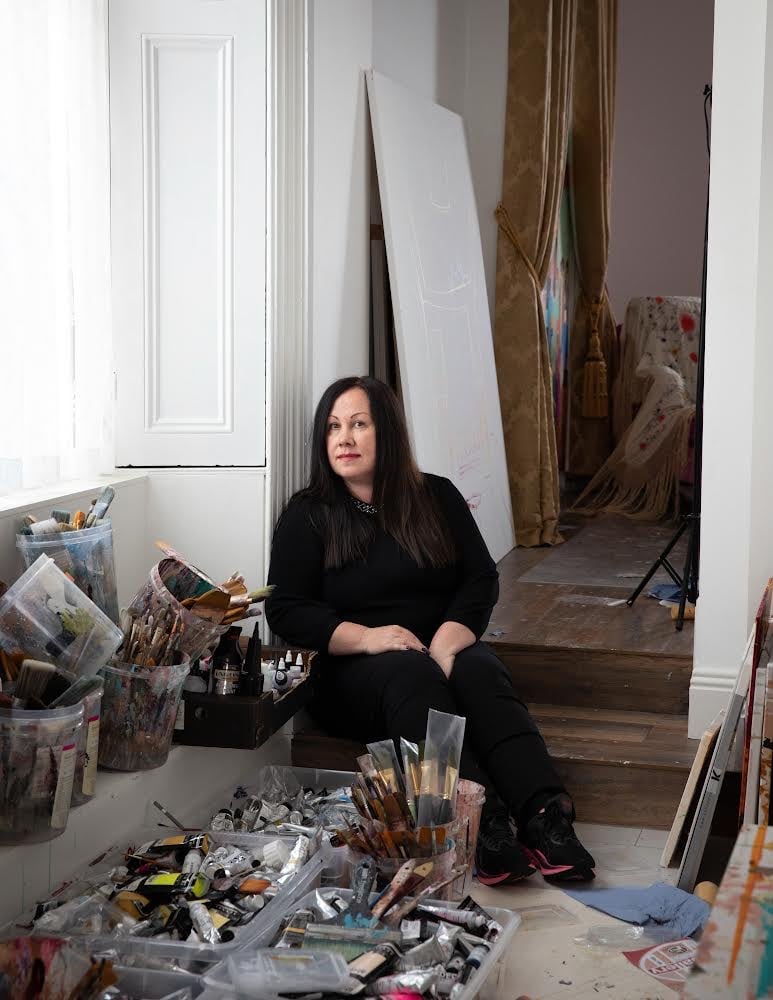Sometime around 2013, Irish artist Genieve Figgis received a Twitter message from someone unexpected.
She had just started using the platform months prior, finding in it something she didn’t have access to elsewhere: a place to show her paintings. “I felt a bit lost and that I did not fit into the idea of what art was in my current environment,” she recalled recently. “I had no hope and nothing to lose.”
Indeed, Figgis didn’t have much of a painting career at that point, nor did she have many connections in the art world. A mother of two in her early 40s who had just completed graduate school at the National College of Art and Design in Dublin the year before, she was painting in her kitchen while her kids were at school. But that all changed with the message.
It was Richard Prince. He wanted to buy one of her works.
Figgis was shocked. “I did not think it was the real Richard Prince,” she said.

Genieve Figgis, Untitled (Lady with a Dog) (2013). Courtesy Susan Barrett.
Her suspicion was understandable. Prince’s online persona, like his own work, is slippery; you’re never quite sure what’s performance and what’s genuine. But by the sound of it, their exchange was pleasantly straightforward—even if Figgis, who at that point had never sold a work of art before, didn’t know how much to charge. (She declined to share the number they settled on.)
Prince walked away with Lady with a bird (2013), a painting that technically depicts exactly what its title suggests, but in typical Figgis fashion, conveys much more. The artwork’s titular figure appears ghostly and crude, as if committed to canvas by a child with a set of drugstore watercolors. Absent are shadows, gradients, and all those other Art 101 techniques. It’s all broad strokes, literally, with swathes of pink paint forming a blanched female face, and a cluster of white dabs coalescing into a toothy grin.
The whole thing is simultaneously funny and haunting, the way a doll can be both innocent plaything and horror-movie villain. Figgis knows that uncanny terrain better than most. It’s the place from which she’s built an impressive career since that message from Prince eight years ago, scoring a name-brand gallery, lofty sales results, and plenty of favorable reviews along the way.
Her recently closed exhibition at Almine Rech’s New York outpost, where prices ranged from $50,000 to $175,000, sold out, while her 2019 painting Wedding Party went for over $500,000 at Phillips Hong Kong last December, around five times its high estimate. Since her work first hit the auction block in 2018, it has generated more than $10 million, according to the Artnet Price Database.
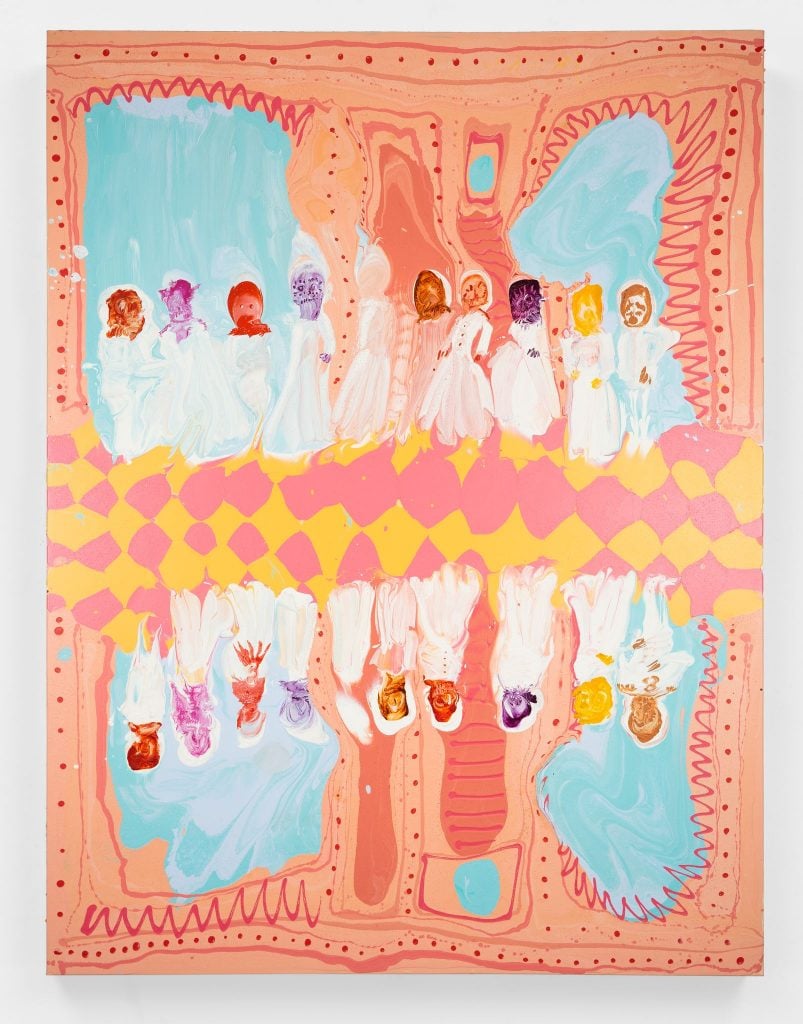
Genieve Figgis, Reflection (2021). © Genieve Figgis. Courtesy of the artist and Almine Rech. Photo: Dan Bradica.
Born in Dublin in 1972, Figgis didn’t grow up around art. The only paintings she knew were the Baroque-era knock-offs that adorned family mantles and school walls in her Catholic community.
She didn’t visit a museum until she was 19. By that point, she had foregone college and married her secondary-school sweetheart; her two children were just a couple of years away.
If that’s an uncommon backstory for a major artist, it’s particularly surprising for Figgis, whose work now feels as though it emerged from a marinade of art-historical hits. Her paintings regularly replicate the look and feel of eras past—Rococo and Romanticism are favorite entry points—only to deconstruct the folly of it all. In Figgis’s world, the stately manors, plush gardens, and ruffled clothing of the genteel class melt into one another, flattened and stripped of grace.
She “favors rich colors that bubble, ooze, and marbleize as if alive,” New York Times critic Roberta Smith wrote in 2014, on the occasion of Figgis’s first solo outing at the star-making Half Gallery in New York. Smith compared Figgis’s work—”full of daffy but spectral creatures and leering ghouls with top hats and canes”—to that of Goya, Karen Kilimnik, and George Condo.
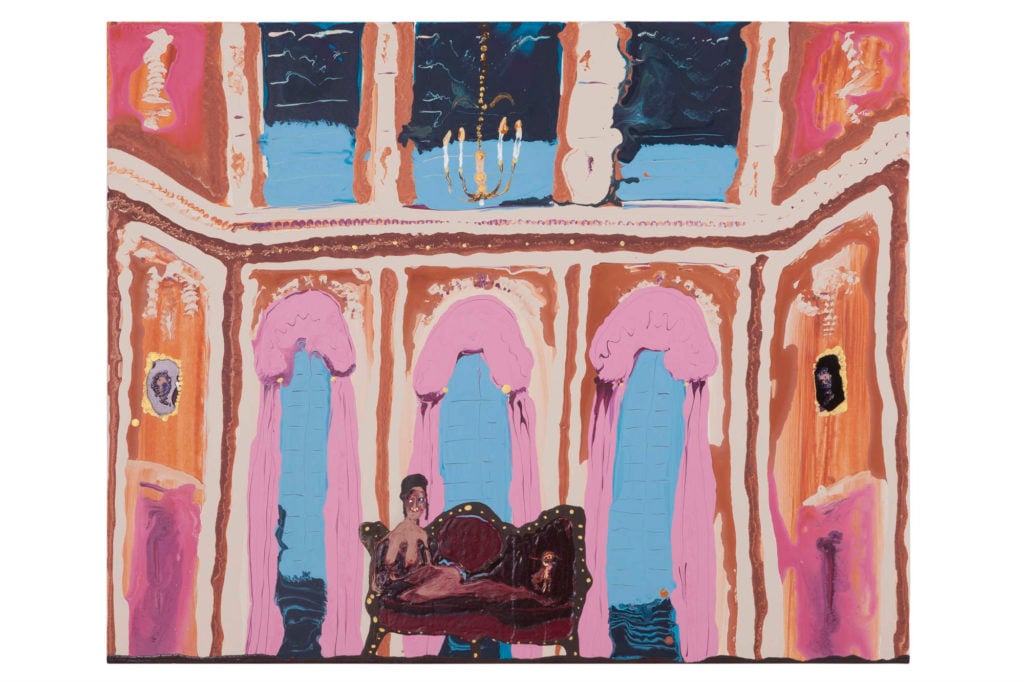
Genieve Figgis, Pink Stage (2017). Courtesy of the artist.
One painting highlighted in Smith’s review, The Swing After Fragonard (2014), typifies the artist’s signature style. An homage to Fragonard’s 18th-century masterpiece, Figgis’s version takes the impossible depth of the original and turns it all mushy, flirting with—but never indulging in—full-on camp. “The lavishly gowned lady seems to be a skeleton,” Smith concluded. “She also might be under water.”
That’s often the impression with which Figgis leaves us. It’s as if somebody spilled a glass of water on a stack of history’s finest portraits, leaving them to dry as diluted versions of their former selves—which is actually not far from how the artist works. Liquid plays a major part in Figgis’s process; she pours it onto the canvas as she goes, letting gravity do as much work as her brush does.
In describing her approach, Figgis recalled a vivid dream she had as a child about living in a house where every room was filled with a different colored liquid. It’s not hard to appreciate its resonance with her artistic efforts today. “I think the dream was a premonition of how I work now, in a studio that is a house, and in every room, I am working on various paintings and pouring liquid paints,” she said.
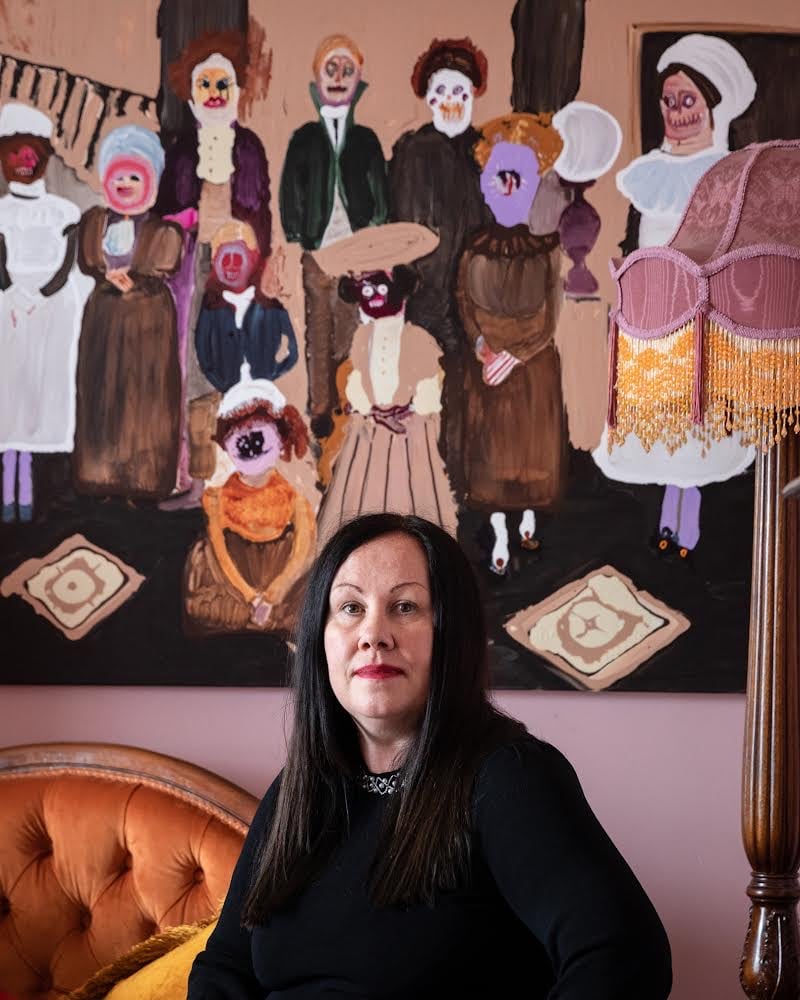
Genieve Figgis. Photo: Doreen Kilfeather. Courtesy of the artist.
In her 20s, Figgis’s energy was subsumed by her role as mom. While she hadn’t yet devoted herself to painting, she found other creative outlets. “I was cooking, baking, making children’s costumes,” she recalled. “It was a highly creative home just like how it was for me growing up.”
Figgis went back to school when she was 30, at least a decade wiser than most of her fellow students at the Gorey School of Art in Wexford, Ireland. “It was my lifelong dream to go to art school, but I just did not get the opportunity until then,” she said. After her bachelor’s degree came the master’s program in Dublin, and it was there that she really fell for art history, borrowing books by the stack from the school library.
While the white, male painters that she studied sought perfection, Figgis developed a style that embraced chaos and change. “I enjoy working with paint that has no guaranteed outcome or shape,” she explained.
After their fateful Twitter exchange, Prince bought a few more paintings, exhibited them at his bookstore-slash-gallery Fulton Ryder, and even published the artist’s first book. “I was able to pay off my college debt,” Figgis recalled. “I was able to leave my part-time shop job that paid me €10 an hour. I was earning only €200 a week [at the time].”
The momentum led to other shows in London and New York and later to representation by dealer Almine Rech, to whom Prince introduced her. For Figgis, the support was transformational—as it would be for any artist, kitchen-based or not. Prince was her first collector in 2014; he’s her biggest collector today. (The artist did not respond to a request for comment.)
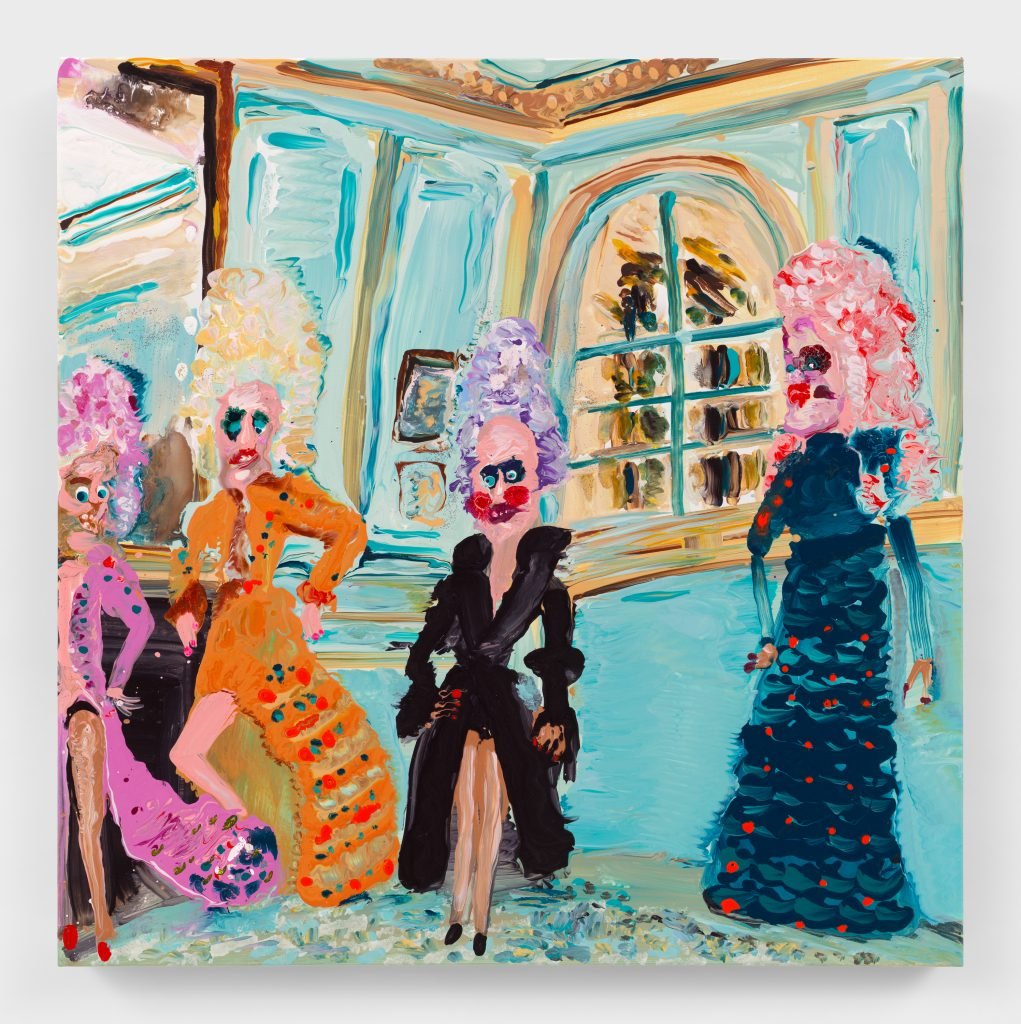
Genieve Figgis, Fashion Shoot (2021). © Genieve Figgis. Courtesy of the artist and Almine Rech. Photo: Dan Bradica.
Figgis has come a long way since those early kitchen days. For one thing, she now operates out of a dedicated building on the Irish coast, her children out of school and on their own (though her son occasionally helps out in the studio). Her work has been acquired by international collectors and institutions including the Beirut-based Tony Salamé, the Nanjing-based Lu Jun, the Pérez Art Museum Miami, and the Smart Museum in Chicago.
“Genieve is a very positive person and she really wants to enjoy her work and share these emotions with the public—that’s very important to her,” said Almine Rech director Gwenvael Launay, who’s worked with Figgis since she joined the gallery in 2015.
While the artist’s profile has expanded, however, her artistic focus has crystallized. Rather than observing and lampooning the absurdity of art history, she’s actively trying to rewrite it—and her version features a lot more powerful women.
“In the Rococo-style paintings, I wanted to recreate the pre-revolutionary world,” she said of her latest body of work. Rather than “just feminine bodies to gaze upon,” her female subjects “are playing the role and having fun themselves. They are the stars of the paintings.”
